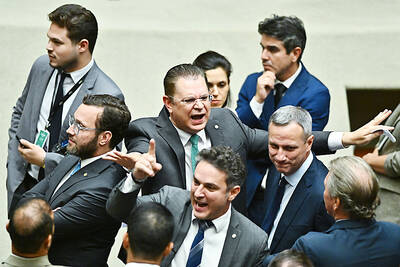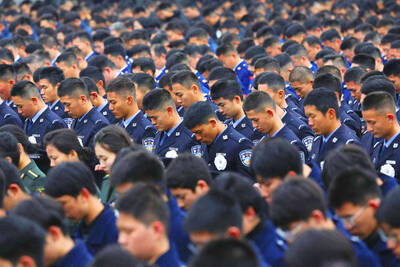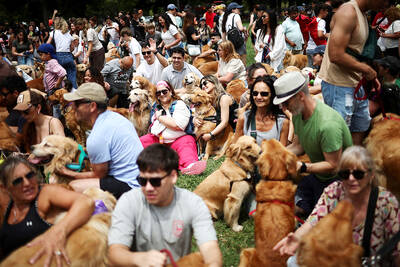It is one of the world's most baffling puzzles, the bane of professional cryptologists and amateur sleuths who have spent 15 years trying to solve it.
But the race to find the secrets of Kryptos, a sculpture inside a courtyard at the CIA's heavily guarded headquarters in Langley, Virginia, may be reaching a climax.
And interest has soared since Dan Brown hid references to Kryptos on the cover design for his bestselling novel The Da Vinci Code, and suggested it might play a role in his next novel, The Solomon Key.
The Kryptos sculpture incorporates a coded message made up of thousands of letters punched through a nearly 4m high copper scroll.
Though it was installed where only CIA agents and cryptographers could see it, amateur code-breakers have worked away on transcripts posted on the CIA's website.
Three-quarters of the code has been broken, and the deciphered message so far appears to point to something momentous buried on CIA grounds.
But the clues are obscure and the fourth passage of the Kryptos code -- known as K4 to the addicted -- has remained impenetrable.
However, Elonka Dunin, who runs the most comprehensive website on Kryptos (www.elonka.com/kryptos) said recent activity has surged.
"My baseline was about 500-600 unique visitors a day. But I recently got 30,000 over a 24-hour period," said Dunin, an executive at a Missouri-based internet game company, Simutronics.
No one is more amazed at the sudden excitement than Kryptos's creator, Jim Sanborn, who was hired in 1989 by the CIA director at the time, William Webster. Sanborn worked with a CIA cryptographer, Ed Scheidt, to produce the coded sculpture, consisting of the S-shaped copper scroll, a petrified tree, a water-filled basin and stones marked with fragments of Morse code and a compass. Placing it in the thick of many of the best code-breakers in the world, they never thought it would take this long.
"These were events I thought would take months not years,"Sanborn, a Washington-based sculptor, commented.
The references to Kryptos on the jacket of The Da Vinci Code were only spotted recently. Now Sanborn is worried that the religious and spiritual overtones of Brown's books could settle on his sculpture.
"Somehow I've been drawn into that vortex," he said.
With that in mind, Sanborn is taking precautions.
"I have taken all Kryptos-related material from my house and studio," he said. "The crypto' world has its share of crazies."
It took eight years for the first three Kryptos passages to be cracked, by a CIA officer named David Stein, after a total of 400 hours with pen and paper.
He was hit, he later wrote "by that sweetly ecstatic, rare experience that I have heard described as a `moment of clarity.'"
This being the CIA, the solution was kept a secret, but it was solved separately by Jim Gillogly, a California computer scientist, who published the first three passages in 1999.
They both used the same method, relying on the fact that the English language uses letters with varying frequencies, allowing code-breakers to calculate which ciphers represent which letters.
The fourth passage has been masked to make that impossible. So far, Gillogly, one of America's best cryptologists, says he has spent "a couple of hundred hours spread over six years" on the 97 remaining letters, with no success.
The solution so far includes a couple of misspellings which Sanborn has said are deliberate.
It gives the coordinates of a spot which seems to be on CIA grounds, and says "only WW" knows the exact location, an apparent reference to William Webster.
It then quotes the diary entry of the archaeologist Howard Carter on finding Tutankhamen's tomb.
After completing the sculpture, Sanborn had to hand Webster an envelope containing the solution, but now suggests he gave neither Webster nor Scheidt, the full story. He insists the fourth passage is decipherable and would not be surprised if it were solved soon. "It's being barraged right now," he said.
Some of the "addicts" are going to remarkable lengths to solve Kryptos.
Gary Phillips, 27, said he had abandoned his software company so that he could devote more time to the code puzzle.
"I can see how some might perceive that I made a sacrifice by closing my business and pursuing Kryptos," Phillips, a Michigan programmer, said.
Sanborn admits he would feel a tinge of regret if Kryptos is solved. He said: "All of us should hope it does survive. There are codes in all our lives that we hope are never deciphered."

PARLIAMENT CHAOS: Police forcibly removed Brazilian Deputy Glauber Braga after he called the legislation part of a ‘coup offensive’ and occupied the speaker’s chair Brazil’s lower house of Congress early yesterday approved a bill that could slash former Brazilian president Jair Bolsonaro’s prison sentence for plotting a coup, after efforts by a lawmaker to disrupt the proceedings sparked chaos in parliament. Bolsonaro has been serving a 27-year term since last month after his conviction for a scheme to stop Brazilian President Luiz Inacio Lula da Silva from taking office after the 2022 election. Lawmakers had been discussing a bill that would significantly reduce sentences for several crimes, including attempting a coup d’etat — opening up the prospect that Bolsonaro, 70, could have his sentence cut to

China yesterday held a low-key memorial ceremony for the 1937 Nanjing Massacre, with Chinese President Xi Jinping (習近平) not attending, despite a diplomatic crisis between Beijing and Tokyo over Taiwan. Beijing has raged at Tokyo since Japanese Prime Minister Sanae Takaichi last month said that a hypothetical Chinese attack on Taiwan could trigger a military response from Japan. China and Japan have long sparred over their painful history. China consistently reminds its people of the 1937 Nanjing Massacre, in which it says Japanese troops killed 300,000 people in what was then its capital. A post-World War II Allied tribunal put the death toll

A passerby could hear the cacophony from miles away in the Argentine capital, the unmistakable sound of 2,397 dogs barking — and breaking the unofficial world record for the largest-ever gathering of golden retrievers. Excitement pulsed through Bosques de Palermo, a sprawling park in Buenos Aires, as golden retriever-owners from all over Argentina transformed the park’s grassy expanse into a sea of bright yellow fur. Dog owners of all ages, their clothes covered in dog hair and stained with slobber, plopped down on picnic blankets with their beloved goldens to take in the surreal sight of so many other, exceptionally similar-looking ones.

‘UNWAVERING ALLIANCE’: The US Department of State said that China’s actions during military drills with Russia were not conducive to regional peace and stability The US on Tuesday criticized China over alleged radar deployments against Japanese military aircraft during a training exercise last week, while Tokyo and Seoul yesterday scrambled jets after Chinese and Russian military aircraft conducted joint patrols near the two countries. The incidents came after Japanese Prime Minister Sanae Takaichi triggered a dispute with Beijing last month with her remarks on how Tokyo might react to a hypothetical Chinese attack on Taiwan. “China’s actions are not conducive to regional peace and stability,” a US Department of State spokesperson said late on Tuesday, referring to the radar incident. “The US-Japan alliance is stronger and more